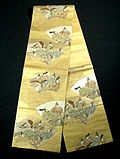Tsujigahana (辻ヶ花) is a Japanese fabric dyeing technique that originated in the Muromachi period. The name tsujigahana translates to "flowers at the crossroads"...
4 KB (504 words) - 16:36, 2 April 2024
Itchiku Kubota (section Tsujigahana technique)
lost late 15th- to early 16th-century textile dye technique known as tsujigahana (lit. "flowers at the crossroads"), which became the main focus for much...
34 KB (3,783 words) - 02:21, 15 July 2024
of floating silk yarns and gilt-paper strips,: 140 and the elaborate tsujigahana technique of combination dyework and embroidery, until both were restrained...
12 KB (1,059 words) - 12:00, 24 September 2022
some historic dyeing techniques – such as the original technique of tsujigahana – now impossible to recreate entirely due to the fact that the fabric...
14 KB (1,466 words) - 14:33, 30 June 2024
such as kurotomesode. Unlike other kimono dyeing techniques such as tsujigahana, yūzen has never fallen out of fashion or been forgotten as a textile...
10 KB (1,144 words) - 09:07, 15 September 2024
previously-popular nerinuki plain-weave silk, which had been used to create tsujigahana. In response to the increasing material wealth of the merchant classes...
128 KB (14,267 words) - 22:22, 8 September 2024
with the time-consuming use of hand-painted dyes, a technique known as tsujigahana (lit. 'flowers at the crossroads'). This was a common technique in the...
42 KB (4,217 words) - 21:01, 28 September 2024
(sewing) Troentorp Clogs Trousers Trucker hat Trunks (clothing) Tsarouhi Tsujigahana Tsunokakushi Tube top Tubeteika Tudong Tudor bonnet Tulle bi telli Tulle...
51 KB (4,819 words) - 23:38, 8 October 2024
previously popular nerinuki plain-weave silk, which had been used to create tsujigahana. In response to the increasing material wealth of the merchant classes...
67 KB (7,646 words) - 17:25, 1 October 2024
Katazome (型絵染) Edo komon (江戸小紋) Nagaita chugata (長板中形) Mokuhan-zome (木版染) Tsujigahana Shibori Some weaving techniques are:[better source needed] Kasuri (絣織)...
32 KB (3,666 words) - 17:32, 1 October 2024
Mandokoro. Kato Kiyomasa, the chief tax collector arrives. He brings a Tsujigahana dyed kimono. One doesn't want it and generously gives it Sasuke for Osen...
47 KB (1,123 words) - 17:52, 5 September 2024
fabric made from raw silk and scoured silk that became essential to the tsujigahana fabric dyeing technique.[citation needed] Following the end of the Ōnin...
7 KB (882 words) - 21:58, 26 September 2023
"Spring Bell" (春の鐘, "Haru no Kane") "Tsujigahana" (辻が花) "Rokumeikan (1)" (鹿鳴館<1>, "Rokumeikan (Ichi)") "Rokumeikan (2)" (鹿鳴館<2>, "Rokumeikan (Ni)") "Rokumeikan...
19 KB (420 words) - 07:18, 14 July 2023









